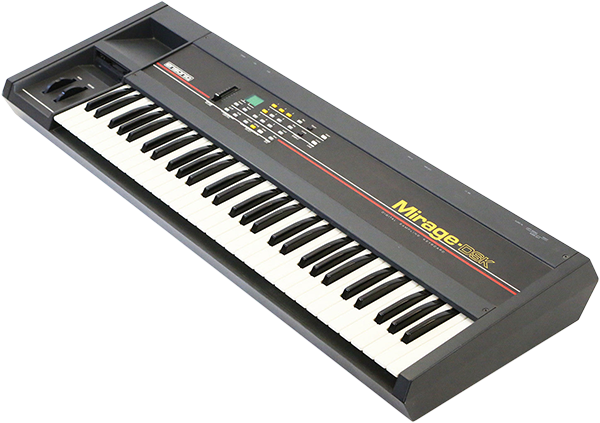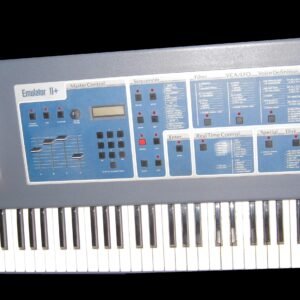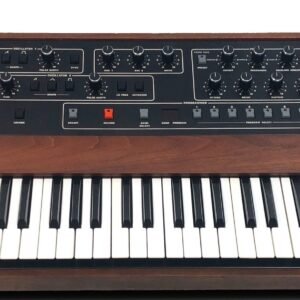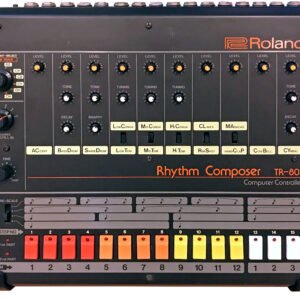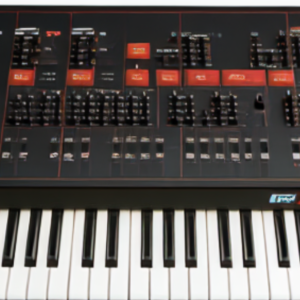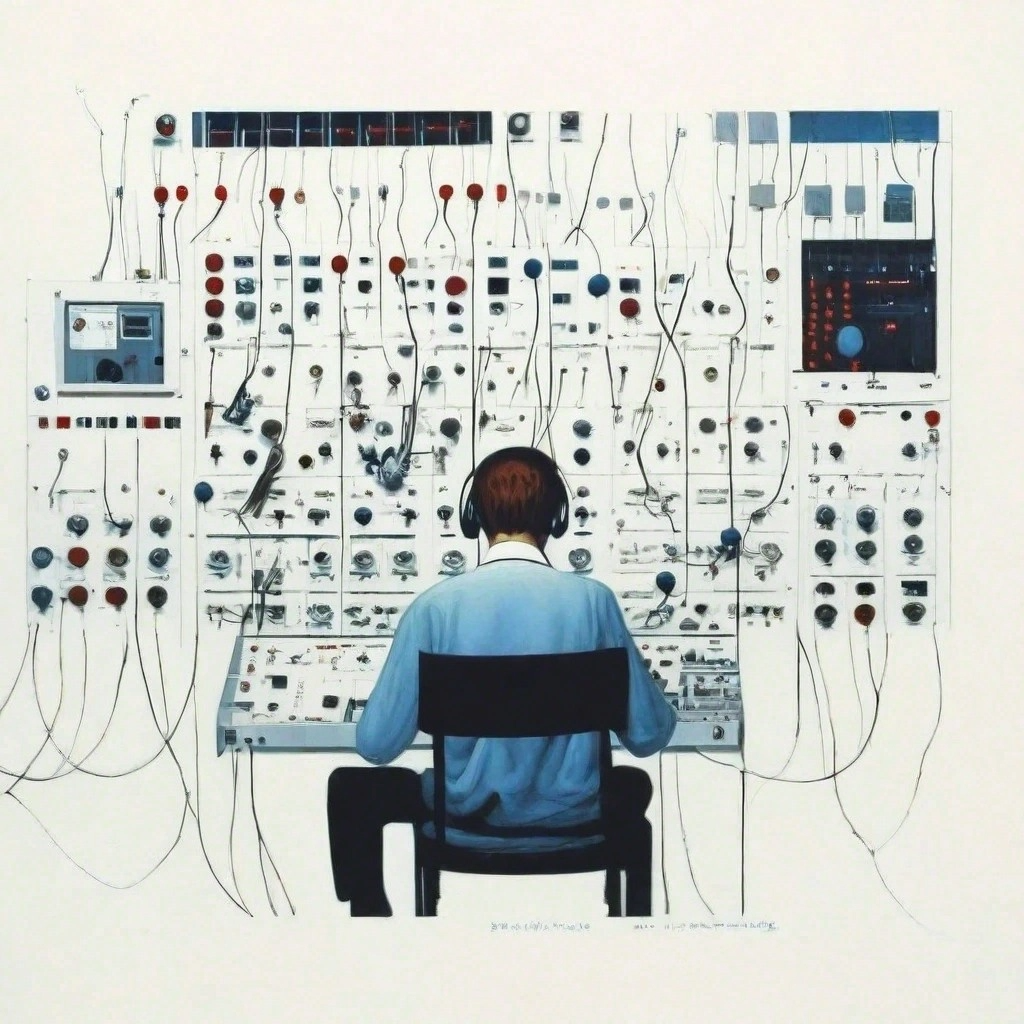The Ensoniq Mirage
The Ensoniq Mirage stands as a groundbreaking milestone in the realm of music technology, heralding a new era of affordable sampling synthesizers. Introduced in 1984 by Ensoniq Corporation, the Mirage was a revolutionary instrument that democratized the process of sampling, previously an exclusive domain of high-end studios due to its prohibitive costs.
At the time of its release, the Mirage offered musicians and producers unprecedented access to sampling capabilities at a fraction of the cost of other samplers on the market. Its advent marked a pivotal moment in music production history, empowering artists with the ability to capture and manipulate real-world sounds with ease.
Ensoniq Corporation, founded by former Commodore engineer Robert “Bob” Yannes, had already gained recognition for its innovative approach to synthesizer design with products like the ESQ-1 and EPS. However, it was the Mirage that truly solidified Ensoniq’s reputation as a trailblazer in the industry.
The Mirage’s design was simple yet effective, featuring a sleek interface that made sampling and editing accessible to musicians of varying skill levels. Its iconic black and yellow color scheme became synonymous with the Ensoniq brand and remains instantly recognizable among music enthusiasts even today.
Despite its relatively modest specifications by modern standards, the Mirage’s impact on music production cannot be overstated. Its ability to capture and manipulate audio in real-time opened up a world of creative possibilities, shaping the sound of countless recordings across multiple genres.
In the decades since its release, the Ensoniq Mirage has garnered a dedicated following among musicians, collectors, and enthusiasts alike. Its enduring legacy as a pioneering instrument continues to inspire new generations of artists to push the boundaries of sonic exploration, cementing its rightful place in the annals of music history.
The Ensoniq Mirage’s design and features were innovative for its time, offering musicians a versatile and user-friendly platform for sampling and synthesis. Here’s a closer look at what made the Mirage stand out:
1. **Compact and Sturdy Build**: The Mirage boasted a compact and sturdy design, making it well-suited for both studio and live performance settings. Its robust construction ensured durability while its manageable size made it easy to transport and integrate into various setups.
2. **Sampling Capabilities**: At the heart of the Mirage was its sampling engine, which allowed users to capture audio from external sources in real-time. With a sampling rate of up to 32 kHz and 8-bit resolution, the Mirage offered decent fidelity for its era, enabling users to create sampled instruments, drum loops, and sound effects with ease.
3. **Polyphonic Keyboard**: The Mirage featured a polyphonic keyboard with velocity sensitivity, providing expressive control over sampled sounds. This allowed for dynamic performances and nuanced expression, enhancing the realism of sampled instruments.
4. **Ample Memory**: Despite its modest specifications compared to modern samplers, the Mirage offered ample memory for storing sampled sounds. Depending on the model and configuration, users could expand the Mirage’s memory capacity to accommodate larger sample libraries, facilitating more extensive musical compositions.
5. **Integrated Sequencer**: Many iterations of the Mirage included an integrated sequencer, enabling users to create and arrange musical sequences directly within the instrument. This streamlined workflow eliminated the need for external sequencers, simplifying the process of composing and arranging music.
6. **Versatile Sound Processing**: In addition to sampling capabilities, the Mirage featured a range of onboard sound processing tools, including filters, envelopes, and modulation options. These tools allowed users to sculpt and manipulate sampled sounds to create unique textures and timbres, further expanding the instrument’s sonic palette.
7. **Expansion Options**: Ensoniq offered various expansion options for the Mirage, allowing users to enhance its capabilities further. These included additional memory expansions, SCSI interfaces for external storage, and even optional floppy disk drives for data backup and transfer.
Overall, the Ensoniq Mirage’s design and features were ahead of its time, offering musicians a powerful and versatile tool for sampling and synthesis. Its intuitive interface, robust construction, and innovative capabilities cemented its status as a legendary instrument in the history of music technology.
The Ensoniq Mirage’s design and features were innovative for its time, offering musicians a versatile and user-friendly platform for sampling and synthesis. Here’s a closer look at what made the Mirage stand out:
1. **Compact and Sturdy Build**: The Mirage boasted a compact and sturdy design, making it well-suited for both studio and live performance settings. Its robust construction ensured durability while its manageable size made it easy to transport and integrate into various setups.
2. **Sampling Capabilities**: At the heart of the Mirage was its sampling engine, which allowed users to capture audio from external sources in real-time. With a sampling rate of up to 32 kHz and 8-bit resolution, the Mirage offered decent fidelity for its era, enabling users to create sampled instruments, drum loops, and sound effects with ease.
3. **Polyphonic Keyboard**: The Mirage featured a polyphonic keyboard with velocity sensitivity, providing expressive control over sampled sounds. This allowed for dynamic performances and nuanced expression, enhancing the realism of sampled instruments.
4. **Ample Memory**: Despite its modest specifications compared to modern samplers, the Mirage offered ample memory for storing sampled sounds. Depending on the model and configuration, users could expand the Mirage’s memory capacity to accommodate larger sample libraries, facilitating more extensive musical compositions.
5. **Integrated Sequencer**: Many iterations of the Mirage included an integrated sequencer, enabling users to create and arrange musical sequences directly within the instrument. This streamlined workflow eliminated the need for external sequencers, simplifying the process of composing and arranging music.
6. **Versatile Sound Processing**: In addition to sampling capabilities, the Mirage featured a range of onboard sound processing tools, including filters, envelopes, and modulation options. These tools allowed users to sculpt and manipulate sampled sounds to create unique textures and timbres, further expanding the instrument’s sonic palette.
7. **Expansion Options**: Ensoniq offered various expansion options for the Mirage, allowing users to enhance its capabilities further. These included additional memory expansions, SCSI interfaces for external storage, and even optional floppy disk drives for data backup and transfer.
Overall, the Ensoniq Mirage’s design and features were ahead of its time, offering musicians a powerful and versatile tool for sampling and synthesis. Its intuitive interface, robust construction, and innovative capabilities cemented its status as a legendary instrument in the history of music technology.
The Ensoniq Mirage’s sound generation capabilities were centered around its innovative sampling engine, which revolutionized the way musicians could capture, manipulate, and reproduce sound. Here’s an in-depth look at how the Mirage handled sound generation:
1. **Sampling Engine**: At the core of the Mirage was its sampling engine, which allowed users to capture audio from external sources in real-time. With a sampling rate of up to 32 kHz and 8-bit resolution, the Mirage provided a decent level of fidelity for its time, enabling users to capture a wide range of sounds with reasonable accuracy.
2. **Sample Playback**: Once audio was captured, the Mirage could play back the sampled sounds across its polyphonic keyboard with velocity sensitivity. This allowed for expressive performances, with the ability to reproduce the nuances of acoustic instruments and other sound sources.
3. **Looping and Editing**: The Mirage offered extensive editing capabilities for sampled sounds, including the ability to loop sections of audio seamlessly. This feature was invaluable for creating sustained sounds like pads and drones, as well as for crafting rhythmic loops and percussion samples.
4. **Filtering and Processing**: In addition to basic playback, the Mirage included built-in filters, envelopes, and modulation options for shaping and processing sampled sounds. Users could apply low-pass, high-pass, and band-pass filters to sculpt the frequency content of samples, while envelopes and modulation sources allowed for dynamic shaping and modulation of parameters such as volume, pitch, and filter cutoff.
5. **Layering and Multitimbrality**: With its multitimbral capabilities, the Mirage allowed users to layer multiple samples together to create rich, complex sounds. This feature was particularly useful for emulating acoustic instruments or crafting unique hybrid sounds by combining disparate elements.
6. **Effects and Processing**: While the Mirage’s onboard effects were relatively basic compared to modern standards, it did offer some onboard processing options such as basic reverb and chorus effects. These effects could be applied globally to the entire sound or on a per-sample basis, adding depth and dimension to the Mirage’s sonic palette.
7. **Modulation and Performance Controls**: The Mirage provided various modulation sources and performance controls for adding movement and expression to sampled sounds. This included LFOs (Low-Frequency Oscillators), modulation envelopes, and real-time performance controls such as pitch bend and modulation wheels, allowing for dynamic and evolving soundscapes.
Overall, the Ensoniq Mirage’s sound generation capabilities were groundbreaking for their time, offering musicians unprecedented flexibility and control over sampled sounds. Whether used for realistic instrument emulation, experimental sound design, or electronic music production, the Mirage’s innovative sampling engine paved the way for future generations of sampling synthesizers.
The Ensoniq Mirage, with its pioneering sampling capabilities, has left an indelible mark on the landscape of music production, influencing a wide array of artists across various genres. Here’s a look at some notable users and the profound influence the Mirage had on their music:
1. **Depeche Mode**: The Mirage found favor among pioneering electronic bands like Depeche Mode, who embraced its sampling capabilities to incorporate unique soundscapes and textures into their music. Tracks like “Personal Jesus” feature distinctive sampled elements that showcase the Mirage’s influence on the band’s sonic palette.
2. **Nine Inch Nails**: Trent Reznor of Nine Inch Nails utilized the Mirage extensively in the band’s early recordings, leveraging its sampling capabilities to create gritty industrial textures and atmospheric soundscapes. The Mirage’s raw, lo-fi aesthetic played a significant role in shaping the band’s signature sound, particularly on albums like “Pretty Hate Machine.”
3. **The Prodigy**: The Mirage played a pivotal role in the early sound of The Prodigy, with Liam Howlett harnessing its sampling capabilities to craft the energetic and aggressive beats that defined the group’s breakout album, “Experience.” Tracks like “Charly” and “Out of Space” feature iconic samples that highlight the Mirage’s influence on the rave and electronic music scenes of the early ’90s.
4. **The Orb**: Ambient pioneers The Orb embraced the Mirage’s sampling capabilities to create immersive, otherworldly soundscapes that pushed the boundaries of electronic music. Tracks like “Little Fluffy Clouds” showcase the Mirage’s ability to capture and manipulate audio in real-time, contributing to the group’s ethereal and atmospheric aesthetic.
5. **Hip-Hop Producers**: In the realm of hip-hop, the Mirage played a significant role in the early sampling culture, providing producers with a versatile tool for chopping and manipulating samples. Artists like DJ Premier, Pete Rock, and Large Professor utilized the Mirage’s sampling capabilities to craft iconic beats that laid the foundation for the genre’s golden era.
6. **Experimental Artists**: The Mirage’s versatility and affordability made it a favorite among experimental musicians and sound artists seeking to push the boundaries of conventional music production. Its ability to capture and manipulate audio in real-time opened up a world of creative possibilities, inspiring artists to explore new sonic territories and redefine the boundaries of musical expression.
Overall, the Ensoniq Mirage’s influence extends far beyond its modest specifications, leaving an indelible imprint on the music of its time and beyond. From electronic pioneers to hip-hop innovators and experimental visionaries, the Mirage continues to inspire artists to push the boundaries of sonic exploration and creativity.
The impact and legacy of the Ensoniq Mirage reverberate through the corridors of music history, leaving an enduring imprint on the evolution of electronic music production. Here’s a closer examination of its profound influence:
1. **Democratization of Sampling**: The Mirage played a pivotal role in democratizing sampling technology, making it accessible to a broader audience of musicians and producers. Its affordable price point and intuitive interface broke down barriers to entry, empowering artists to experiment with sampled sounds and revolutionize music production.
2. **Pioneering Innovation**: As one of the first affordable sampling synthesizers on the market, the Mirage pioneered a new era of sonic exploration. Its groundbreaking sampling engine paved the way for future advancements in sampling technology, inspiring a wave of innovation and creativity in the music industry.
3. **Shaping Electronic Music**: The Mirage left an indelible mark on the landscape of electronic music, shaping the sound of countless recordings across multiple genres. From pioneering electronic bands like Depeche Mode to hip-hop producers and experimental artists, its influence can be heard in a diverse array of musical styles and movements.
4. **Cultural Icon**: Beyond its technical specifications, the Mirage attained a cult status among musicians, collectors, and enthusiasts. Its distinctive sound and iconic design have earned it a place of reverence in the annals of music history, with many regarding it as a cultural icon that symbolizes the spirit of innovation and creativity.
5. **Educational Tool**: The Mirage served as an educational tool for aspiring musicians and producers, providing hands-on experience with sampling technology. Its user-friendly interface and versatile capabilities made it an ideal platform for learning the fundamentals of music production, inspiring future generations of artists to explore the possibilities of sound.
6. **Continued Influence**: Despite advancements in technology, the Mirage’s legacy endures, with its influence felt in modern music production techniques and electronic music genres. Its raw, lo-fi aesthetic continues to resonate with artists seeking to evoke nostalgia or capture the essence of a bygone era, ensuring its relevance in contemporary music-making.
In summary, the Ensoniq Mirage’s impact and legacy extend far beyond its technical specifications, embodying the spirit of innovation, creativity, and accessibility that continues to shape the world of music production. As a pioneering instrument that paved the way for future generations of samplers and synthesizers, its influence remains palpable in the sonic tapestry of modern music.
The Ensoniq Mirage holds a special place in the hearts of musicians, collectors, and enthusiasts alike, contributing to its enduring collector’s value and influencing market trends in the realm of vintage music gear. Here’s a closer look at its collector’s value and market trends:
1. **Vintage Appeal**: As a pioneering sampling synthesizer from the 1980s, the Mirage holds significant vintage appeal among collectors and aficionados of retro music gear. Its iconic design, distinctive sound, and historical significance make it a coveted item for collectors seeking to own a piece of music history.
2. **Limited Availability**: Despite its popularity, the Mirage is no longer in production, leading to a limited supply of available units on the market. This scarcity has contributed to its collector’s value, with well-maintained and fully functional units commanding premium prices among collectors and enthusiasts.
3. **Rising Prices**: Over the years, the prices of Ensoniq Mirage units have steadily risen on the vintage music gear market, reflecting growing demand and dwindling supply. Mint-condition units with all original accessories and documentation can fetch significant sums, especially among collectors seeking pristine examples of this iconic instrument.
4. **Modding and Customization**: In addition to stock units, modified or customized Mirage units have also gained popularity among collectors and enthusiasts. Custom upgrades such as expanded memory, MIDI retrofits, and aftermarket accessories can enhance the functionality and versatility of the Mirage, further increasing its appeal to collectors and musicians alike.
5. **Community and Support**: The Mirage boasts a dedicated community of users, collectors, and enthusiasts who share a passion for this iconic instrument. Online forums, social media groups, and dedicated websites serve as hubs for Mirage enthusiasts to exchange knowledge, share experiences, and buy/sell/trade Mirage-related gear, contributing to its enduring popularity and collector’s value.
6. **Investment Potential**: For some collectors, the Ensoniq Mirage represents not only a piece of music history but also a potential investment opportunity. With prices steadily appreciating over time, owning a Mirage unit can be seen as a sound investment in vintage music gear, offering both intrinsic value as a musical instrument and the potential for future financial gain.
Overall, the Ensoniq Mirage’s collector’s value and market trends reflect its status as a beloved icon of vintage music technology. Whether sought after for its historical significance, distinctive sound, or investment potential, the Mirage continues to captivate the imaginations of collectors and enthusiasts worldwide, ensuring its enduring legacy in the annals of music gear history.
The Ensoniq Mirage stands as a testament to innovation and contribution in the realm of music technology, with several key innovations that have shaped the course of electronic music production. Here are some of its notable innovations and contributions:
1. **Affordable Sampling**: One of the most significant contributions of the Mirage was its role in democratizing sampling technology. By offering a relatively affordable sampling synthesizer, Ensoniq made sampling accessible to a broader audience of musicians and producers who previously may not have had access to such capabilities. This democratization of sampling paved the way for a new era of music production, with sampling becoming a ubiquitous tool in the creation of electronic music.
2. **Real-time Sampling and Editing**: The Mirage introduced the concept of real-time sampling and editing, allowing musicians to capture audio from external sources and manipulate it directly within the instrument. This real-time sampling capability revolutionized the way music was created, enabling artists to capture inspiration on the fly and experiment with new sonic textures and ideas in real-time.
3. **Integrated Sequencing**: Many iterations of the Mirage featured an integrated sequencer, further expanding its capabilities as a standalone music production tool. The integration of sequencing functionality allowed users to create and arrange musical sequences directly within the instrument, streamlining the workflow and eliminating the need for external sequencers.
4. **User-friendly Interface**: The Mirage boasted a user-friendly interface that made sampling and editing accessible to musicians of varying skill levels. Its intuitive design and layout made it easy to navigate and understand, reducing the learning curve for users new to sampling technology and encouraging experimentation and creativity.
5. **Versatile Sound Processing**: In addition to sampling capabilities, the Mirage offered a range of onboard sound processing tools, including filters, envelopes, and modulation options. These versatile processing tools allowed users to sculpt and manipulate sampled sounds to create unique textures and timbres, expanding the Mirage’s sonic palette and creative potential.
6. **Cultural Impact**: Beyond its technical innovations, the Mirage had a profound cultural impact on the music industry, influencing the sound of countless recordings across multiple genres. Its distinctive lo-fi aesthetic and raw, gritty sound became synonymous with the electronic music of the era, shaping the sonic landscape of the 1980s and beyond.
Overall, the Ensoniq Mirage’s innovations and contributions have left an indelible mark on the world of music technology, paving the way for future advancements in sampling synthesis and inspiring generations of musicians and producers to push the boundaries of sonic exploration and creativity.
The Ensoniq Mirage cultivated a vibrant community of users, enthusiasts, and support networks that contributed to its enduring legacy in the world of music technology. Here’s a closer look at the community and support surrounding the Mirage:
1. **Online Forums and Communities**: Dedicated online forums and communities have sprung up around the Mirage, providing a platform for users and enthusiasts to connect, share knowledge, and exchange tips and tricks. These forums serve as valuable resources for troubleshooting technical issues, discussing sound design techniques, and sharing user-created content such as sample libraries and patches.
2. **Social Media Groups**: Social media platforms have also become hubs for Mirage enthusiasts to gather and interact. Facebook groups, Reddit communities, and Twitter hashtags dedicated to the Mirage offer opportunities for users to connect with like-minded individuals, share their experiences with the instrument, and seek advice from fellow enthusiasts.
3. **User Groups and Meetups**: In addition to online communities, offline user groups and meetups provide opportunities for Mirage users to come together in person, exchange ideas, and collaborate on music projects. These gatherings often feature workshops, demonstrations, and performances showcasing the Mirage’s capabilities and inspiring creativity among attendees.
4. **Technical Support Resources**: Despite being a vintage instrument, the Mirage continues to enjoy robust technical support from third-party repair technicians, restoration specialists, and DIY enthusiasts. Online tutorials, repair guides, and video walkthroughs offer valuable resources for troubleshooting common issues, performing maintenance, and restoring vintage Mirage units to optimal working condition.
5. **Legacy Support from Ensoniq**: While Ensoniq Corporation ceased production of the Mirage decades ago, the company’s legacy lives on through its continued commitment to supporting users of its vintage products. Ensoniq’s website offers resources such as product manuals, firmware updates, and legacy support contacts for users seeking assistance with their Mirage units.
6. **Third-party Software and Hardware**: A thriving ecosystem of third-party software and hardware has emerged around the Mirage, offering users additional tools and accessories to enhance their experience with the instrument. From software editors and libraries to hardware expansions and modifications, these offerings provide users with new ways to unlock the full potential of their Mirage units.
Overall, the community and support surrounding the Ensoniq Mirage reflect its enduring popularity and significance in the world of music technology. Whether connecting online, gathering offline, or accessing technical resources, Mirage enthusiasts have forged a strong and supportive community that continues to celebrate and preserve the legacy of this iconic instrument.
The Ensoniq Mirage stands as a timeless testament to innovation, creativity, and community in the realm of music technology. From its humble beginnings as a pioneering sampling synthesizer to its enduring legacy as a beloved icon of vintage music gear, the Mirage has left an indelible mark on the world of electronic music production.
Throughout its storied history, the Mirage has captivated the imaginations of musicians, producers, and enthusiasts alike, inspiring countless artists to push the boundaries of sonic exploration and creativity. Its groundbreaking sampling capabilities democratized sampling technology, making it accessible to a broader audience of musicians and paving the way for a new era of music production.
Beyond its technical specifications, the Mirage’s cultural impact and influence on the music industry are undeniable. From iconic bands and artists who embraced its gritty lo-fi sound to a dedicated community of users and enthusiasts who continue to celebrate its legacy, the Mirage remains a cherished symbol of innovation and inspiration.
As we reflect on the Mirage’s rich history and enduring legacy, it serves as a reminder of the transformative power of music technology to shape the course of musical innovation and creativity. Whether as a vintage collector’s item, a cherished studio tool, or a source of inspiration for future generations of musicians, the Ensoniq Mirage will forever hold a special place in the hearts of music enthusiasts around the world.
